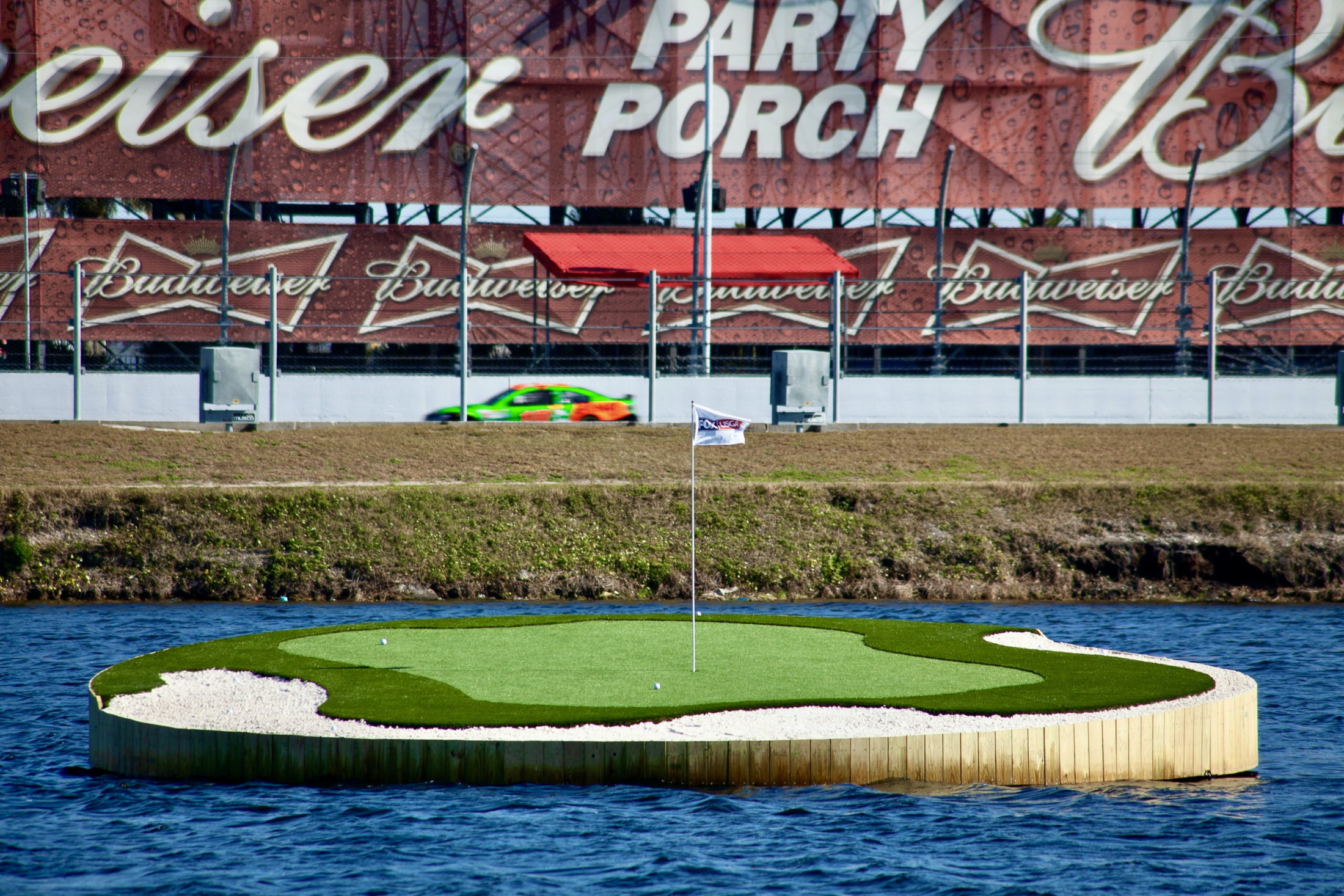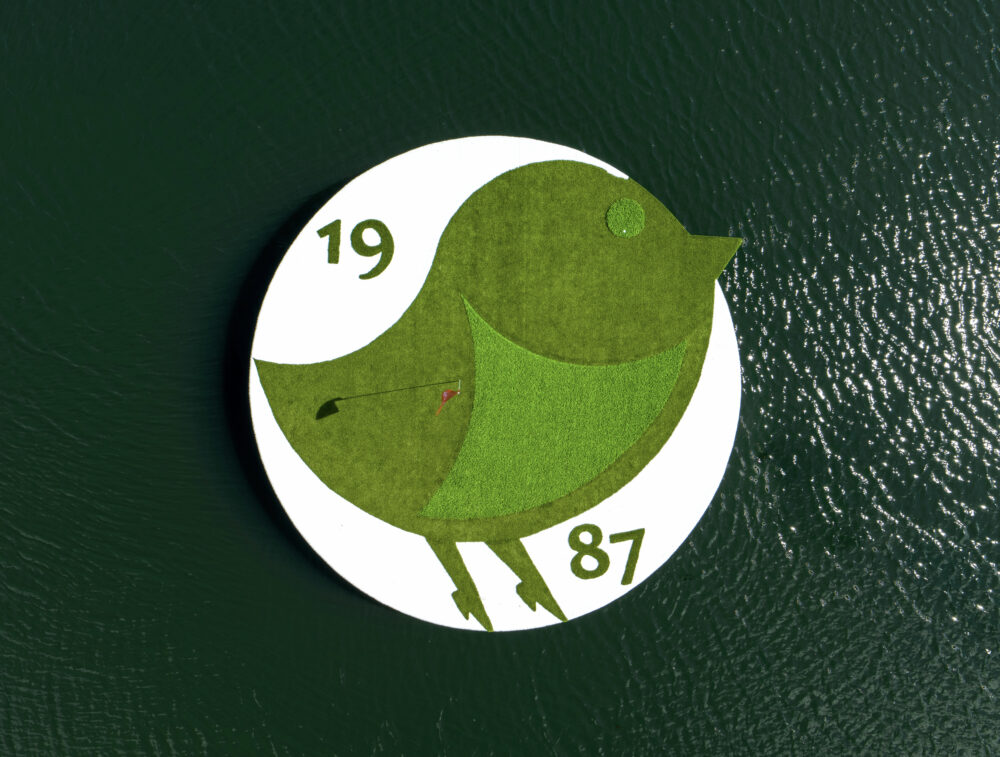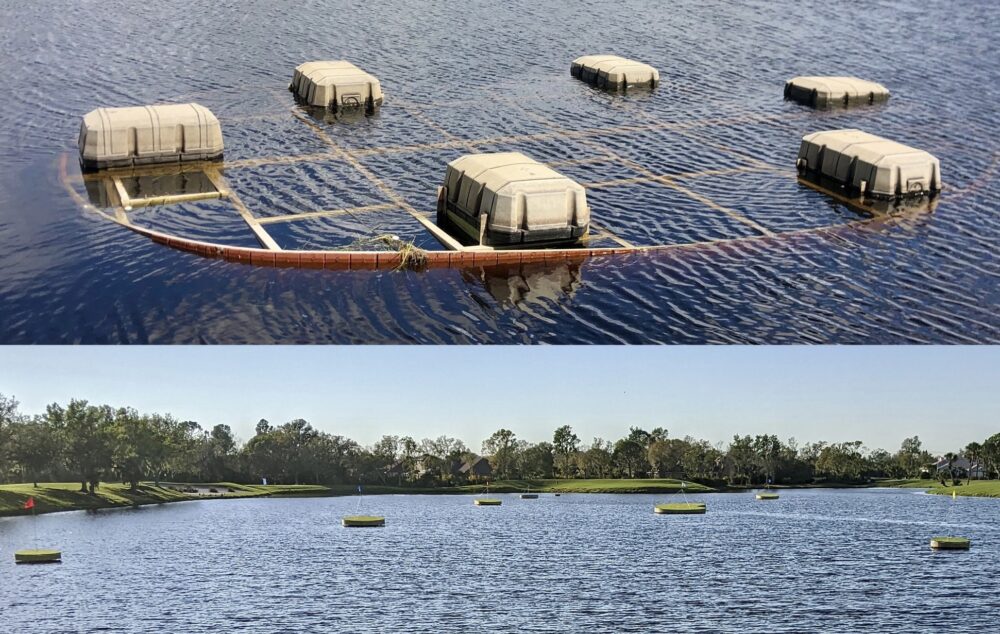
Aqua Greens Once Made Pit Stop at Daytona 500
Back in late December 2014, Aqua Greens received a phone call from Jeff Gajewski, VP of Business Development for JHE Production (now CSM Sport & Entertainment). JHE was the event management team in charge of cross-promoting the upcoming 2015 U.S. Open Championship on FOX Sports, which was also broadcasting the Daytona 500 in February.
This was a big deal for FOX, which had just signed a 12-year, $1.2 billion pact for the broadcast rights to the prestigious golf championship (among other USGA championships), and JHE needed something that would present well on television. That’s where Aqua Greens came in. JHE had this idea to place an island green in Lloyd Lake, which sits in the infield of Daytona International Speedway directly across from the main grandstand. Their plan was to invite LPGA star Paula Creamer as well as several NASCAR drivers and various members of FOX Sports broadcast team, including Brad Faxon, and have them take a crack at hitting balls onto the island green in a special event leading up to the race. The green would then remain in the lake for the broadcast of the Daytona 500.
The catch was that the green had to look authentic, it had to play like a normal green AND it had to be designed, approved and built in less than eight weeks. It normally takes Aqua Greens two to four months to custom design and build a green of this magnitude, says Aqua Greens owner Matthew Gault. Aqua Greens did it in a little more than a month.
“When you have a paying customer like FOX Sports, you triple your labor force and you bang it out,” said Gault.
The first step in the process was to design a green that had the look and feel of Chambers Bay, a links-style, public golf course south of Seattle that was hosting its first major championship. Noting the towering sand dunes and the large number of bunkers on the course, Gault chose to model the island green after the signature par-3 15th hole and its well-defended green, which is surrounded on all but one side by a massive bunker.
“We wanted to convey something specific about the course that would help them communicate something about the tournament, and so we came up with the bunker-oriented concept,” said Gault.
Gault’s team then put together a computer-animated design, or CAD, of their concept—which included a gigantic, rooftop tee that Aqua Greens built for a previous Red Bull event in Atlantic City. (The tee was eventually not used.) FOX and JHE loved the bunkered-green concept, and not more than a week after being initially contacted by JHE, Aqua Greens was moving full steam ahead on the engineering phase of the project.
The purpose of the engineering phase is “to figure out how to make the structure do what we want it to do,” says Gault. In other words, make the green float and lay flat in the water. “If you don’t get the weight right, the green will float crooked or sag in the water on one end.”
Gault had his own in-house architect map out the structural design of the 32-foot circular green, which included a loading profile as well as stress and weight simulations so that the builders knew how much each area of the aluminum frame weighed. He also had him draw a two-dimensional top view of the green surface, which provided basic landmarks as to where the curves and shapes of the bunkers were as well as the contours on the green.
The green Aqua Greens built for Daytona had no contours—it was a straight-forward, flat-top surface that gradually pitched from a high of 36 inches in the back to 10 inches in the front. This is a standard design for Aqua Greens so that the green can be clearly seen by the golfer on the tee. Aqua Greens can bend the aluminum surface to create more of a three-dimensional, undulating surface with all kinds of slopes and bends, although it’s a very time consuming and expensive process.
Once all of the computer drawings were finished and the engineering process completed, the next stop was to go in the New Hampshire-based shop and build the green. This meant bending the metal, setting up the aluminum frame and then putting the lumber on it, including the sidewall skirt. The green was then loaded into a truck, in several pieces, and shipped to the Speedway where the structure was off-loaded and bolted together, and the carpet surface installed and infilled with about three tons of green sand. Finally, the green was towed out to the location and anchored in place.
The Daytona green took all but three weeks to build and was a huge hit with the golfers and drivers who took part in the promotional event, which included three-time Daytona 500 winner Denny Hamlin and two-time winner Michael Waltrip. Gault and his team even got to hit balls onto the green as the stands filled just prior to the start of the race, often referred to as NASCAR’s ‘Super Bowl.’
“I had eight guys working that job, and it still took us two 16-hour days to get the green ready on time,” said Gault. “The entire project was a constant adrenaline rush for all of us. It really was an awesome effort, and by the time my crew stepped away and the cameras were ready, the green was 110 percent ready for FOX Sports.”
Aqua Greens can custom design and build an island green for any corporate or brand activation event, or for home usage or any rental outing. For more information, please call 800-884-4882 or email aquagreensgolf@gmail.com.
Creamer, Waltrip Take Aim at Daytona Island Green




